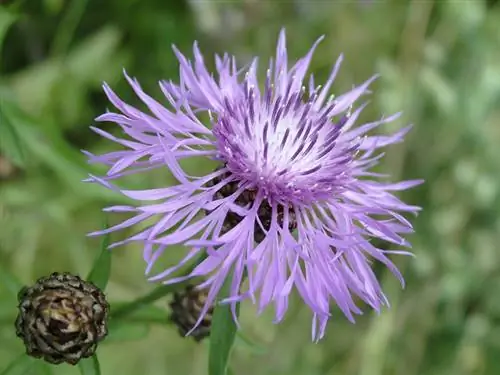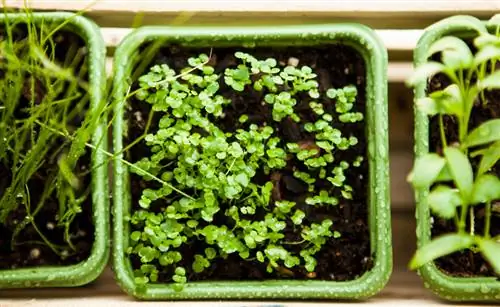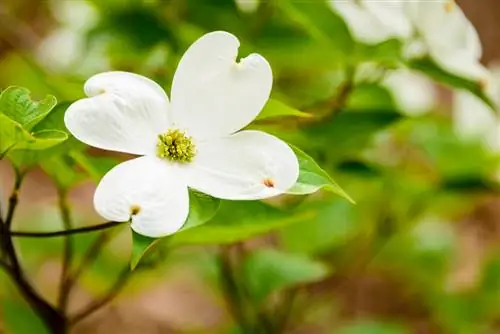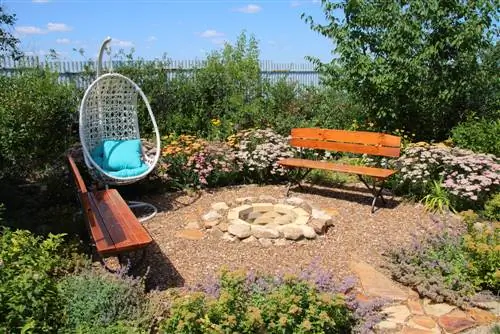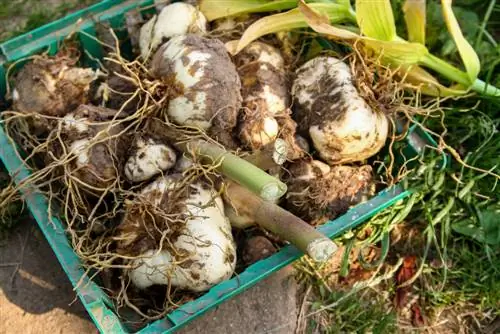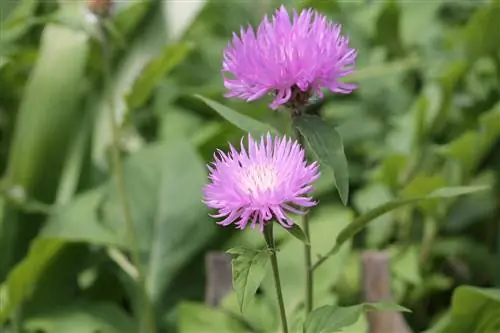- Author admin [email protected].
- Public 2023-12-25 17:45.
- Last modified 2025-01-23 11:22.
The knapweed genus gifts us with an abundance of colorful, airy summer flowers. Equipped with a sunny disposition, the distinctive perennials adorn natural gardens, enclosures, cottage gardens, herbaceous beds and the side of the path. The following answers to frequently asked questions show how easy these bold flower beauties are to care for.
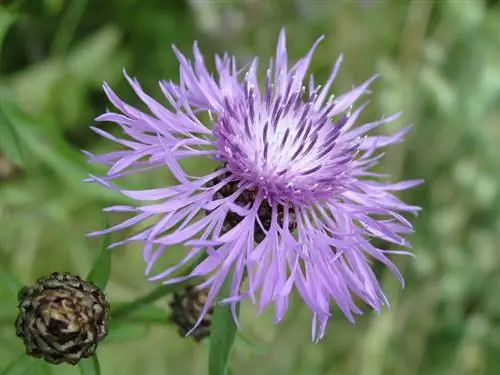
What are the ideal conditions for knapweeds in the garden?
Knapweeds are easy-care, colorful summer flowers that are ideal for natural gardens, cottage gardens and perennial beds. They need a sunny location, humus-rich, nutrient-rich soil, regular watering and fertilization as well as pruning after the flowering period.
Planting knapweed correctly
Knapweeds grown behind glass in February or bought ready-made at the garden center should ideally be planted in the bed from the end of April. A further planting date is late summer, when the soil has warmed up deeply. As long as you prepare the humus, nutrient-rich soil in a sunny location with fine crumbs, soak the root balls of the young plants that are still potted in water. This is how the work continues:
- Dig small pits at a distance of 30-40 cm, spacious enough for a root ball
- Enrich the excavated soil with compost, horn shavings, bark humus or guano granules
- Unpot a knapweed, position it in the middle of the hole and plant it just below the first pair of leaves
- Watering and mulching with leaves, bark mulch or grass clippings
The wild herbaceous nature of a knapweed comes into its own in a rustic clay pot. Use common compost-based potting soil as a substrate and add a handful of sand. Place some pottery shards over the opening in the bottom of the pot as drainage.
Care tips
The care program for a knapweed is so uncomplicated that even beginner gardeners can handle it without any problems. All important aspects at a glance:
- Water regularly when dry
- During the growing season, fertilize in the bed every 4 weeks, in the pot every 2 weeks
- Clean up wilted and faded things as soon as possible
- Pruning close to the ground after the first flowering period
In autumn or late winter, cut the perennial back again; this time down to 10 cm above the ground. Since the knapweed is completely hardy, there is no need for winter protection.read more
Which location is suitable?
If a sunny to full sun location is available in the garden, the knapweeds are there as busy, permanent bloomers. The summer perennials show their most beautiful side in the deeply humus-rich and nutritious soil, which tends to be fresh, moist and calcareous.read more
What soil does the plant need?
The knapweed expresses its inimitable wild perennial character wherever the soil is humus, loose and nutrient-rich. A slight lime content is just as welcome as fresh soil moisture without the risk of waterlogging. Nevertheless, the robust perennial also tolerates sandy-loamy soil as long as there is a rich population of microorganisms there.
When is flowering time?
The knapweed sets off its striking fringed or pompom flowers from May to July. If you can't get enough of the pretty summer perennials, cut the withered flowers close to the ground after the first blooming period and pamper them with a portion of compost. The floral ambassadors of summer lightness then get ready for another appearance on the garden stage.
Cut knapweed correctly
In order to successfully cultivate a knapweed, secateurs are essential equipment. We have put together all the occasions when the perennial is cut for you here:
- Cut newly bloomed stems down to at least two leaves for the vase
- Clean out wilted flower stems as soon as possible to make room for further shoots
- After the first flowering period, cut back close to the ground for late summer blooms
The scissors will be used for the last time of the season in autumn. Now cut the knapweed to 10 cm above the ground. If you want to give the natural perennial enough time to sow seeds, postpone the pruning date until February.
Watering knapweed
Knapweed has little tolerance for drought. Therefore, do not let the perennial thirst. As soon as the soil has dried in the upper area, water it. Ideally, you should avoid overhead watering so as not to affect the pretty flowers. The water is applied directly to the root area using the can spout.
Fertilize knapweed correctly
It is by no means one of the ascetic summer perennials. In addition to a balanced water balance, the knapweed also requires a regular supply of nutrients. Fertilize the summer flower in the bed every 4 weeks from May until the end of the flowering period with compost (€12.00 on Amazon) and horn shavings or plant manure. In the pot, the cheeky flower beauty thanks you for the administration of liquid fertilizer every 14 days.
Diseases
Hobby gardeners rarely have to complain about plant diseases on knapweed. If problems arise, the ubiquitous fungal infection mildew is usually behind it. If you notice the first signs of the mealy-gray coating on leaves and shoots, fight it with fresh milk. Water and fresh milk are mixed in a ratio of 9:1 and applied with a hand sprayer every 2-3 days.
Wintering
After the knapweed has withdrawn its above-ground parts of the plant in winter or these have been cut off, frosty temperatures cannot cause any damage to the root ball. The strongest species can withstand temperatures up to -45 degrees Celsius. Even less robust breeds can still withstand the winter down to -28 degrees Celsius. Protective measures are therefore unnecessary.
Propagate knapweed
Where the knapweed has established itself in the garden, there are three uncomplicated methods of propagation. The following overview shows how you can grow more specimens of these charming fringed heads in no time:
- Dividing the root ball in spring or autumn
- Removal of root cuttings in summer to allow them to root in the pot
- Sowing seeds behind glass from February
If you know how to keep pecking birds and voracious pests away from a seedbed, sow directly outdoors in September. You can look forward to the first flowering of seedling-propagated knapweed in the second or third year after sowing.
Is knapweed poisonous?
Although Greek mythology reports that the centaur Chiron healed Achilles' foot wound with a flower of the genus Centaurea, knapweed has no healing powers. There are also no toxic ingredients in flowers, leaves or seeds. The flirtatious perennial is therefore ideal for cultivation in the family garden.
Beautiful varieties
- Grandiflora: The cornflower-blue flowers create a picturesque picture in beds and pots; Growth height 40 cm
- Major: The fluffy flower balls shine in violet pink towards the sun; Growth height 70-80 cm
- Jordy: The variety impresses with its extravagant flowers, the edges of which are particularly frayed; Growth height 30-40 cm
- Alba: A top-class mountain knapweed with pure white flowers from May to July; Growth height up to 80 cm
- Carnea: An enrichment for the fragrance garden, because the light pink fringed flowers smell of peach; Growth height 40-50 cm

